Text this colour links to Pages. Text this colour links to Family Trees. Text this colour are links that are disabled for Guests.
Place the mouse over images to see a larger image. Click on paintings to see the painter's Biography Page. Mouse over links for a preview. Move the mouse off the painting or link to close the popup.
John William Waterhouse 1849-1917 is in Painters.
On or before 6th April 1849 John William Waterhouse was born at Rome, Italy [Map]. He was baptised on 6th April 1949.
In 1854 John William Waterhouse (age 4) and his family moved back to England.
1872. John William Waterhouse (age 22). "Undine".
Undine: Undine is an elemental being associated with water, stemming from the alchemical writings of Paracelsus.
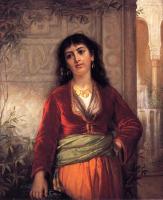
1873. John William Waterhouse (age 23). "The Unwelcome Companion: A Street Scene in Cairo".
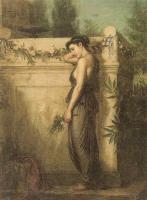
1873. John William Waterhouse (age 23). "Gone, But Not Forgotten".
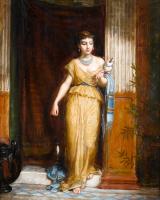
1874. John William Waterhouse (age 24). "La Fileuse" aka The Spinner.
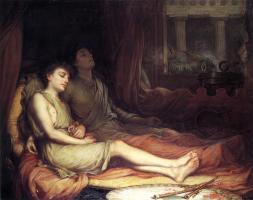
1874. John William Waterhouse (age 24). "Sleep and his Half-brother Death".

1874. John William Waterhouse (age 24). "In the Peristyle".
1875. John William Waterhouse (age 25). "Miranda". Miranda gazing out to sea watching the ship fail in the storm at the commencement of The Tempest.
Miranda: he was born to Duke Prospero.
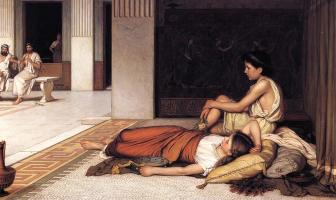
1876. John William Waterhouse (age 26). "After The Dance".
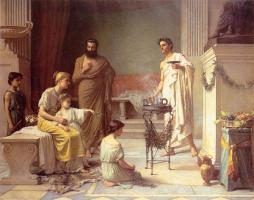
1877. John William Waterhouse (age 27). "A Sick Child brought into the Temple of Aesculapius".
All About History Books
The Chronicle of Walter of Guisborough, a canon regular of the Augustinian Guisborough Priory, Yorkshire, formerly known as The Chronicle of Walter of Hemingburgh, describes the period from 1066 to 1346. Before 1274 the Chronicle is based on other works. Thereafter, the Chronicle is original, and a remarkable source for the events of the time. This book provides a translation of the Chronicle from that date. The Latin source for our translation is the 1849 work edited by Hans Claude Hamilton. Hamilton, in his preface, says: "In the present work we behold perhaps one of the finest samples of our early chronicles, both as regards the value of the events recorded, and the correctness with which they are detailed; Nor will the pleasing style of composition be lightly passed over by those capable of seeing reflected from it the tokens of a vigorous and cultivated mind, and a favourable specimen of the learning and taste of the age in which it was framed." Available at Amazon in eBook and Paperback.
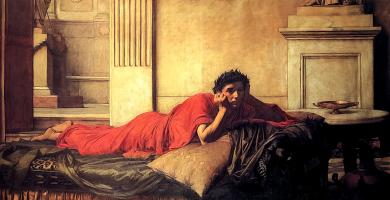
1878. John William Waterhouse (age 28). "The Remorse of the Emperor Nero after the Murder of his Mother".
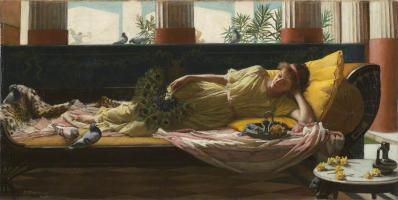
1880. John William Waterhouse (age 30). "Dolce far Niente" aka The Art of Doing Nothing.
1882. John William Waterhouse (age 32). "Diogenes".
Diogenes 412BC 323BC: In 412BC or 404BC he was born. Before 323BC Diogenes 412BC 323BC made a virtue of poverty. He begged for a living and often slept in a large ceramic jar, or pithos, in the marketplace. In 323BC he died.
1883. John William Waterhouse (age 33). "The Favourites of the Emperor Honorius".
Flavius Honorius Emperor: On 9th September 384 he was born to Theodosius I Emperor and Aelia Flaccilla Empress. On 15th August 423 he died.
In 1883 John William Waterhouse (age 33) and Esther Kenworthy (age 26) were married.
1884. John William Waterhouse (age 34). Portrait of [his wife] Esther Kenworthy (age 27), the artist's wife.
Esther Kenworthy: In 1857 she was born. In 1883 John William Waterhouse and she were married. In 1944 she died. She was buried at Kensal Green Cemetery [Map].
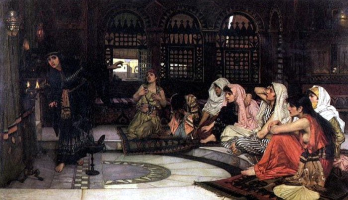
1884. John William Waterhouse (age 34). "Consulting the Oracle".
1885. John William Waterhouse (age 35). "Saint Eulalia".
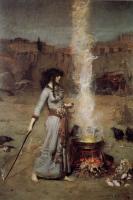
1886. John William Waterhouse (age 36). "The Magic Circle". The painting was puchased by the Tate Gallery for £650.
1887. John William Waterhouse (age 37). "Mariamne Leaving the Judgement Seat of Herod".
Mariamne the Hasmonean 29BC: he was born to Alexander of Judaea 48BC. In 29BC Mariamne the Hasmonean 29BC was executed on the orders of her husband Herod The Great 72BC 4BC.
Herod The Great 72BC 4BC: In 72BC he was born. In 4BC or 1BC he died.
1888. John William Waterhouse (age 38). "The Lady of Shalott". Part 4 Stanza 3 although not quite consistent with the poem "She loos'd the chain, and down she lay; The broad stream bore her far away ...". She holds on to the mooring chain, about to let go. Two of the three candles are extinguished, signifying the end of life.
1888. John William Waterhouse (age 38). "Cleopatra".
1889. John William Waterhouse (age 39). "Ophelia".

1890. John William Waterhouse (age 40). "A Roman Offering".
1891. John William Waterhouse (age 41). "Ulysses and the Sirens".
Ulysses: Metamorphoses Book 14. The lover Glaucus wept. He fled the embrace of Circe and her hostile power of herbs and magic spells. But Scylla did not leave the place of her disaster; and, as soon as she had opportunity, for hate of Circe, she robbed Ulysses of his men. She would have wrecked the Trojan ships, if she had not been changed beforehand to a rock which to this day reveals a craggy rim. And even the rock awakes the sailors' dread.
1891. John William Waterhouse (age 41). "Circe Offering the Cup to Ulysses".
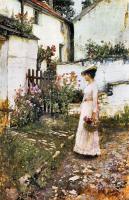
1892 to 1893. John William Waterhouse (age 42). "Gathering Summer Flowers in a Devonshire Garden".
1892. John William Waterhouse (age 42). "Circe Invidiosa" aka Circe Jealous.
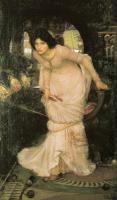
1893. John William Waterhouse (age 43). From Stanza 5 of The Lady of Shalott Part 3 - she looking at Lancelot.

1893. John William Waterhouse (age 43). "La Belle Dame Sans Merci by John Keats".
All About History Books
The Deeds of King Henry V, or in Latin Henrici Quinti, Angliæ Regis, Gesta, is a first-hand account of the Agincourt Campaign, and subsequent events to his death in 1422. The author of the first part was a Chaplain in King Henry's retinue who was present from King Henry's departure at Southampton in 1415, at the siege of Harfleur, the battle of Agincourt, and the celebrations on King Henry's return to London. The second part, by another writer, relates the events that took place including the negotiations at Troye, Henry's marriage and his death in 1422.
Available at Amazon as eBook or Paperback.
1894. John William Waterhouse (age 44). "Ophelia".
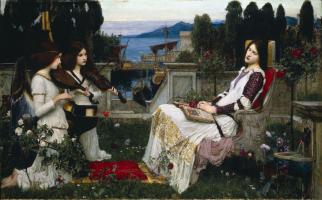
1895. John William Waterhouse (age 45). "St Cecilia".

1895. John William Waterhouse (age 45). "The Shrine".
In 1895 John William Waterhouse (age 45) was appointed Associate of the Royal Academy.
1895. John William Waterhouse (age 45). "Lady of Shalott". Part 3 Stanza 5: "Out flew the web and floated wide; The mirror crack'd from side to side".
1896. John William Waterhouse (age 46). "Hylas and the Nymphs".
1896. John William Waterhouse (age 46). "Pandora". Opening the box - see Hesiod's Works and Days Lines 83 to 108 lines 90-94.
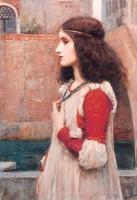
1898. John William Waterhouse (age 48). "Juliet".
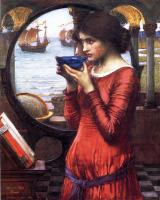
1900. John William Waterhouse (age 50). "Destiny".
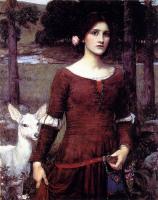
1900. John William Waterhouse (age 50). "The Lady Clare".
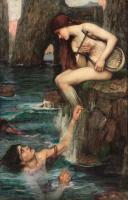
1900. John William Waterhouse (age 50). "The Siren".
All About History Books
The Deeds of King Henry V, or in Latin Henrici Quinti, Angliæ Regis, Gesta, is a first-hand account of the Agincourt Campaign, and subsequent events to his death in 1422. The author of the first part was a Chaplain in King Henry's retinue who was present from King Henry's departure at Southampton in 1415, at the siege of Harfleur, the battle of Agincourt, and the celebrations on King Henry's return to London. The second part, by another writer, relates the events that took place including the negotiations at Troye, Henry's marriage and his death in 1422.
Available at Amazon as eBook or Paperback.
1900. John William Waterhouse (age 50). "Nymphs Finding the Head of Orpheus".
Orpheus: Orpheus is a legendary musician and prophet in ancient Greek religion.
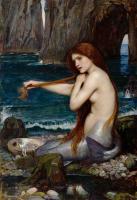
1901. John William Waterhouse (age 51). "The Mermaid".
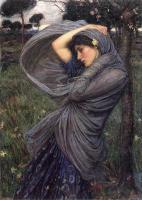
1902. John William Waterhouse (age 52). "Boreas" aka the personification of the North Wind.
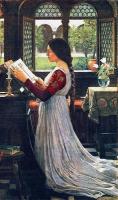
1902. John William Waterhouse (age 52). "The Missal".
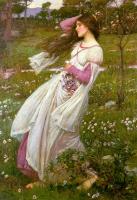
1902. John William Waterhouse (age 52). "Windflowers".
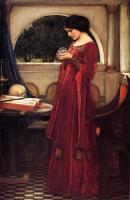
1902. John William Waterhouse (age 52). "The Crystal".
1903. John William Waterhouse (age 53). "Psyche Opening the Golden Box". When she was near Olympus, Psyche opened the box of Persephone's beauty, but the only thing inside was the essence of death. Psyche died, but her husband, Eros, who had forgiven her, saved Psyche's life and took her to Olympus. Psyche was made the goddess of the soul. Psyche and Eros had a daughter, Hedone, goddess of physical joy.
1903. John William Waterhouse (age 53). "Echo and Narcissus".
Echo: Echo is an Oread who resided on Mount Cithaeron.
1904. John William Waterhouse (age 54). "Psyche Opening the Door into Cupid's Garden".
1905. John William Waterhouse (age 55). "Lamia".
Lamia: Lamia. A child-eating monster and, in later tradition, was regarded as a type of night-haunting spirit. Lamia was a beautiful queen of Libya who had an affair with Zeus. Upon learning this, Zeus's wife Hera robbed her of her children, the offspring of her affair with Zeus, either by kidnapping or killing them. The loss of her children drove Lamia insane, and in vengeance and despair, Lamia snatched up any children she could find and devoured them.

1907. John William Waterhouse (age 57). "Isabella and the Pot of Basil" from the Keats Poem from the Decameron Day Four Story Five.
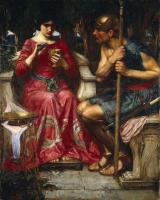
1907. John William Waterhouse (age 57). "Jason and Medea". The painting depicts the Colchian princess, Medea, preparing a magic potion for Jason to enable him to complete the tasks set for him by her father, Aeëtes.
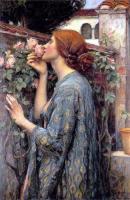
1908. John William Waterhouse (age 58). "The Soul of the Rose" or "My Sweet Rose".
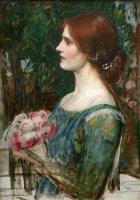
1908. John William Waterhouse (age 58). "The Bouquet".
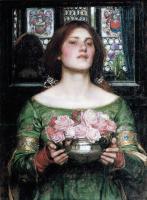
1908. John William Waterhouse (age 58). "Gather Ye Rosebuds While Ye May".
1909. John William Waterhouse (age 59). "Thisbe".
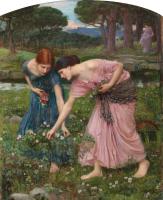
1909. John William Waterhouse (age 59). "The Soul of the Rose" or "My Sweet Rose".
1910. John William Waterhouse (age 60). "Ophelia".
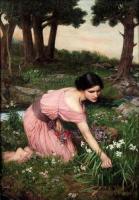
1910. John William Waterhouse (age 60). "Spring Spreads One Green Lap of Flowers".
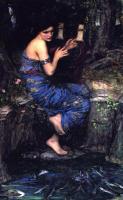
1911. John William Waterhouse (age 61). "The Charmer".
All About History Books
The Chronicle of Abbot Ralph of Coggeshall describes the reigns of Kings Henry II, Richard I, John and Henry III, providing a wealth of information about their lives and the events of the time. Ralph's work is detailed, comprehensive and objective. We have augmented Ralph's text with extracts from other contemporary chroniclers to enrich the reader's experience. Available at Amazon in eBook and Paperback.
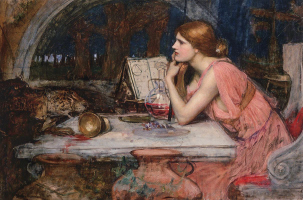
1911. John William Waterhouse (age 61). "The Sorceress".
1911. John William Waterhouse (age 61). Portrait of Miss Betty Pollock (age 12).
Elizabeth Mary Pollock: On 3rd August 1898 she was born to Adrian Donald Wilde Pollock. On 6th January 1970 Elizabeth Mary Pollock died.
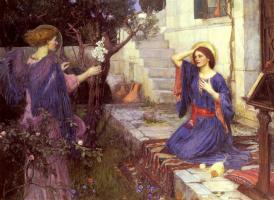
1914. John William Waterhouse (age 64). "The Annunciation".
1916. John William Waterhouse (age 66). "Tristan and Isolde".
Tristan: Tristan and Iseult is a chivalric romance retold in numerous variations since the 12th century, with a lasting impact on Western culture. The story is a tragedy about the adulterous love between the Cornish knight Tristan (Tristram) and the Irish princess Iseult (Isolde, Yseult). It tells of Tristan's mission to escort Iseult from Ireland for marriage to his uncle, King Mark of Cornwall. On the journey home, the two of them ingest a love potion which brings about the adulterous relationship.
1916. John William Waterhouse (age 66). "I am Half-Sick of Shadows, said the Lady of Shalott". Lady of Shalott Part 2 Stanza 4.

1916. John William Waterhouse (age 66). "A Tale from the Decameron".
1917. John William Waterhouse (age 67). "Fair Rosamund".
All About History Books
The Deeds of King Henry V, or in Latin Henrici Quinti, Angliæ Regis, Gesta, is a first-hand account of the Agincourt Campaign, and subsequent events to his death in 1422. The author of the first part was a Chaplain in King Henry's retinue who was present from King Henry's departure at Southampton in 1415, at the siege of Harfleur, the battle of Agincourt, and the celebrations on King Henry's return to London. The second part, by another writer, relates the events that took place including the negotiations at Troye, Henry's marriage and his death in 1422.
Available at Amazon as eBook or Paperback.
On 10th February 1917 John William Waterhouse (age 67) died. He was buried at Kensal Green Cemetery [Map].
In 1944 [his former wife] Esther Kenworthy (age 87) died. She was buried at Kensal Green Cemetery [Map].